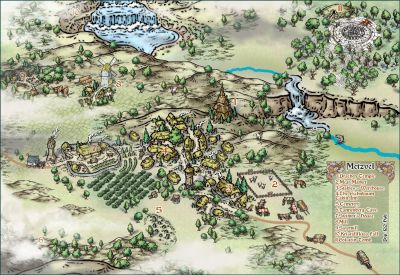
Monsen
Monsen
About
- Username
- Monsen
- Joined
- Visits
- 693
- Last Active
- Roles
- Administrator
- Points
- 8,956
- Birthday
- May 14, 1976
- Location
- Bergen, Norway
- Website
- https://atlas.monsen.cc
- Real Name
- Remy Monsen
- Rank
- Cartographer
- Badges
- 27
-
ProFantsy & Ptolus
Doing a map of that size isn't a problem in CC3+. But it will be a bit time consuming, a map like that is not done in an afternoon.
Since you're mentioning the isometric Schley city set, i am not convinced it will be appropriate for such a large city. I haven't tried, but the isometric sets are generally better when you can see the details a bit more clearly. Might be a good resource for mapping closeup of individual districts for example.
Personally, I am not convinced it is a good starting point doing such a large map if you are unfamiliar with CC3+ though. I recommend starting with something simpler to get some experience first, or it is likely to be overwhelming.
You might want to have a look at this live stream recording where Ralf starts making a small city. Far from the size of your desired city, but shows off the tools and techniques.
-
A Question about Political Borders
-
About map printing
The only difference between regular image exporting and rectangular section is that after you have clicked save in the save as dialog, instead of starting the export immediately, you will be prompted (on the CC3+ command line) to pick two opposite corners of your export (by clicking your mouse in the drawing or typing in the coordinates, either works). CC3+ will then export only the parts that is within the area defined by those points instead of the entire map.
The export process is explained in detail with images in the user manual, starting on page 47.
-
About map printing
If you are printing, there is a tiling option right in the print dialog, just set the desired scale (battle maps for miniatures are usually 1' = 5" (as long as your map is mapped to scale in the first place)) and set the horizontal and vertical number of tiles. Check page 47 of the user manual for details.
If you are exporting it to image files first, you can use the "Rectangular section" file type exports. This will cause CC3+ to ask you for coordinates after hitting save, and this way you can save just a piece of your map. Just use this to export your map one piece at a time.
-
duplicating the Tome pdf file
The file is locked for editing to ensure people don't create and publish modified versions of the document. Unfortunately, that also prevents creating personal bookmarks.
There shouldn't be any problem duplicating the file. All the pdf viewers I load the protected file up in allows me to use
save asto save a copy, or I can just go into the directory (@documentation) and make a copy manually using the windows file explorer. But none of this will change the write protection of the file however, it will just give you a second protected copy.To avoid scrolling to the page, I recommend using the bookmarks already there. Every single heading in the book is already bookmarked in the bookmark bar in the pdf file, displayed to the left in most pdf viewers. The entries are collapsed by default to avoid having to scroll through tons of bookmarks, it is easier to just expand the node you need. You can also click on the entries on the Table of Content pages to go directly to the page. If you know the page number you want, most pdf viewers also lets you easily jump directly to the page, in Acrobat for example, the shortcut is Shift+Ctrl+N, or simply click into the page box in the navigation bar and type in the page number there







